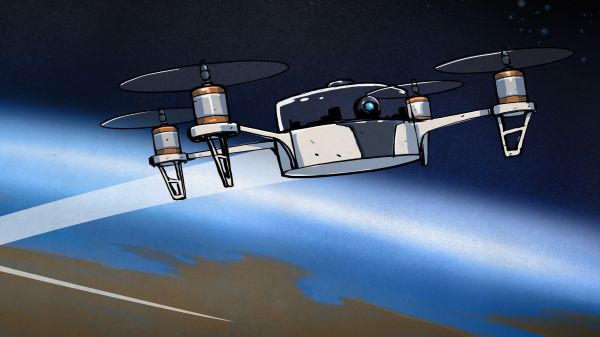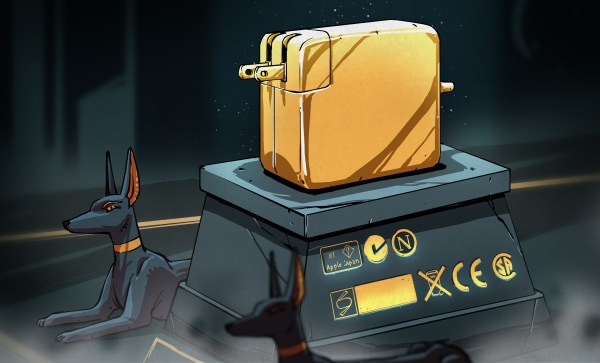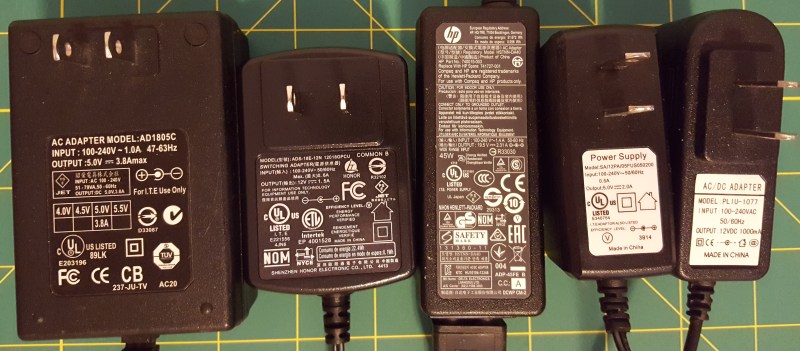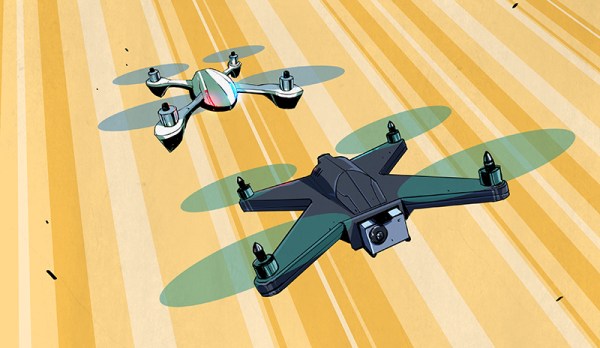For some reason, we never tire of stories highlighting critical infrastructure that’s running outdated software, and all the better if it’s running on outdated hardware. So when we learned that part of the San Francisco transit system still runs on 5-1/4″ floppies, we sat up and took notice. The article is a bit stingy with the technical details, but the gist is that the Automatic Train Control System was installed in the Market Street subway station in 1998 and uses three floppy drives to load DOS and the associated custom software. If memory serves, MS-DOS as a standalone OS was pretty much done by about 1995 — Windows 95, right? — so the system was either obsolete before it was even installed, or the 1998 instance was an upgrade of an earlier system. Either way, the San Francisco Municipal Transportation Agency (SFMTA) says that the 1998 system due to be replaced originally had a 25-year lifespan, so they’re more or less on schedule. Replacement won’t be cheap, though; Hitachi Rail, the same outfit that builds systems that control things like the bullet train in Japan, is doing the job for the low, low price of $212 million.
regulations6 Articles
Federal Aviation Administration Announces Major Drone Rule Changes
If new rules from the FAA regarding unmanned aircraft operations in the US are any indication, drones are becoming less of a niche hobby and more integrated into everyday life. Of course, the devil is in the details, and what the Federal Aviation Administration appears to give with one hand, it takes away with the other.
The rule changes, announced on December 28, are billed as “advanc[ing] safety and innovation” of the drone industry in the United States. The exciting part, and the aspect that garnered the most attention with headline writers, is the relaxation of rules against night operation and operating above people and moving vehicles. Since 2016, it has been against FAA regulations to operate drones less than 55 pounds (25 kg) at night or over people without a waiver. This rule can be seen as stifling innovations in drone delivery, since any useful delivery service will likely need to overfly populated areas and roadways and probably do so at night. The new rules allow these operations without a waiver for four categories of drones, classified by how much damage they would do if they were to lose control and hit someone. The rules also define the inspection and certification regimes for both aircraft and pilot, as well as stipulating that operators have to have their certificate and ID on their person while flying.
While this seems like great news, the flip side of the coin is perhaps less shiny. The rule changes also impose the requirement for “Remote ID” (PDF link), which is said to be “a major step toward full integration of drones into the national airspace system.” Certain drones will be required to carry a system that transmits identification messages directly from the aircraft, including such data as serial number, location and speed of the drone, as well as the location of the operator. The rules speculate that this would likely be done over WiFi or Bluetooth, and would need to be receivable with personal wireless devices. The exact technical implementation of these rules is left as an exercise to manufacturers, who have 30 months from the time the rules go into effect in January to design systems, submit them for certification, and get them built into their aircraft. Drone operators have an additional year to actually start using the Remote ID drones.
For the drone community, these rule changes seem like a mixed bag. To be fair, it’s not exactly unexpected that drones would be radio tagged like this, and the lead time allowed by the FAA for compliance on Remote ID seems generous. The ability to operate in riskier environments will no doubt be welcomed by commercial drone operators. So who knows — maybe the rules will do what they say they will, and this will stimulate a little innovation in the industry. If so, it could make this whole thing a net positive.
Wind Farms In The Night: On-Demand Warning Lights Are Coming
There appears to be no shortage of reasons to hate on wind farms. That’s especially the case if you live close by one, and as studies have shown, their general acceptance indeed grows with their distance. Whatever your favorite flavor of renewable energy might be, that’s at least something it has in common with nuclear or fossil power plants: not in my back yard. The difference is of course that it requires a lot more wind turbines to achieve the same output, therefore affecting a lot more back yards in total — in constantly increasing numbers globally.
Personally, as someone who encounters them occasionally from the distance, I find wind turbines mostly to be an eyesore, particularly in scenic mountainous landscapes. They can add a futuristic vibe to some otherwise boring flatlands. In other words, I can not judge the claims actual residents have on their impact on humans or the environment. So let’s leave opinions and emotions out of it and look at the facts and tech of one issue in particular: light pollution.
This might not be the first issue that comes to mind when thinking about wind farms. But wind turbines are tall enough to require warning lights for air traffic safety, and can be seen for miles, blinking away in the night sky. From a pure efficiency standpoint, this doesn’t seem reasonable, considering how often an aircraft is actually passing by on average. Most of the time, those lights simply blink for nothing, lighting up the countryside. Can we change this?
Continue reading “Wind Farms In The Night: On-Demand Warning Lights Are Coming”
The Great Ohio Key Fob Mystery, Or “Honey, I Jammed The Neighborhood!”
Hack long enough and hard enough, and it’s a pretty safe bet that you’ll eventually cause unintentional RF emissions. Most of us will likely have our regulatory transgression go unnoticed. But for one unlucky hacker in Ohio, a simple project ended up with a knock at the door by local authorities and pointed questions to determine why key fobs and garage door remotes in his neighborhood and beyond had suddenly been rendered useless, and why his house seemed to be at the center of the disturbance.
Few of us want this level of scrutiny for our projects, so let’s take a more in-depth look at the Great Ohio Key Fob Mystery, along with a look at the Federal Communications Commission regulations that govern what you can and cannot do on the airwaves. As it turns out, it’s easy to break the law, and it’s easy to get caught.
Continue reading “The Great Ohio Key Fob Mystery, Or “Honey, I Jammed The Neighborhood!””
What Are Those Hieroglyphics On Your Laptop Charger?
Look on the back of your laptop charger and you’ll find a mess of symbols and numbers. We’d bet you’ve looked at them before and gleaned little or no understanding from what they’re telling you.
These symbols are as complicated as the label on the tag of your shirt that have never taught you anything about doing laundry. They’re the marks of standardization and bureaucracy, and dozens of countries basking in the glow of money made from issuing certificates.
The switching power supply is the foundation of many household electronics — obviously not just laptops — and thus they’re a necessity worldwide. If you can make a power supply that’s certified in most countries, your market is enormous and you only have to make a single device, possibly with an interchangeable AC cord for different plug types. And of course, symbols that have meaning in just about any jurisdiction.
In short, these symbols tell you everything important about your power supply. Here’s what they mean.
Continue reading “What Are Those Hieroglyphics On Your Laptop Charger?”
Let Skynet Become Self-Aware!
Not so long ago, it was hard to fly. Forget actual manned aircraft and pilots licenses; even flying model aircraft required hours of practice, often under the tutelage of a master at a flying field. But along with that training came an education in the rules of safe flight, including flying at a designated airfield and watching out for obstacles.
We accidentally messed that up. We in the drone industry made aircraft super easy to fly — perhaps too easy to fly. Thanks to smart autopilots and GPS, you can open a box, download an app and press “take off”. The copter will dutifully rise into the air and wait there for further instructions — no skill required. And it will do this even if you happen to be in an NFL football stadium in the middle of a big game. Or near an airport. Or in the midst of a forest fire.
The problem is that along with taking training out of the process of flying a drone, we inadvertently also took out the education process of learning about safe and responsible flight. Sure, we drone manufacturers include all sorts of warning and advisories in our instructions manual (which people don’t read) and our apps (which they swipe past), and companies such as DJI and my own 3DR include basic “geofencing” restrictions to try to keep operators below 400 feet and within “visual line of sight”. But it’s not enough.
Every day there are more reports of drone operators getting past these restrictions and flying near jetliners, crashing into stadiums, and interfering with first responders. So far it hasn’t ended in tragedy, but the way things are going it eventually will. And in the meantime, it’s making drones increasingly controversial and even feared. I call this epidemic of (mostly inadvertent) bad behavior “mass jackassery”. As drones go mass market, the odds of people doing dumb things with them reach the singularity of certainty.
We’ve got to do something about this before governments do it for us, with restrictions that catch the many good uses of drones in the crossfire. The reality is that most drone operators who get in trouble aren’t malicious and may not even know that what they’re doing is irresponsible or even illegal. Who can blame them? It’s devilishly hard to understand the patchwork quilt of federal, state and local regulations and guidelines, which change by the day and even the hour based on “airspace deconfliction” rules and FAA alerts written for licensed pilots and air traffic control. Many drone owners don’t even know that such rules exist.
Drones Themselves Should Know Rules of Each Area
Fortunately, they don’t have to. Our drones can be even smarter — smart enough to know where they should and shouldn’t fly. Because modern drones are connected to phones, they’re also connected to the cloud. Every time you open their app, that app can check online to find appropriate rules for flight where you are, right then and there.
Here’s how it works. The app sends four data fields to a cloud service: Who (operator identifier), What (aircraft identifier), Where (GPS and altitude position) and When (either right now or a scheduled time in the case of autonomous missions). The cloud service then returns a “red light” (flight not allowed), a “green light” (flight allowed, with basic restrictions such as a 400 feet altitude ceiling), or “yellow light” (additional restrictions or warnings, which can be explained to the operator in context and at the point of use).
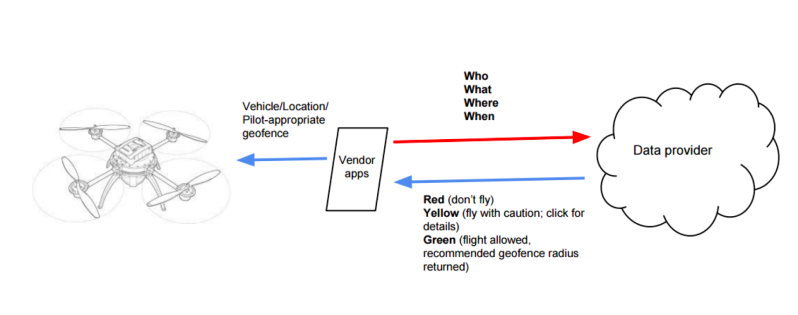
Right now industry groups such as the Dronecode Foundation, the Small UAV Coalition (I help lead both of them, but this essay just reflects my own personal views) and individual manufacturers such as 3DR and DJI are working on these “safe flight” standards and APIs. Meanwhile, a number of companies such as Airmap and Skyward are building the cloud services to provide the up-to-date third-party data layer that any manufacturer can use. It will start with static no-fly zone data such as proximity to airports, US national parks and other banned airspace such as Washington DC. But it will quickly add dynamic data, too, such as forest fires, public events, and proximity to other aircraft.
(For more on this, you can read a white paper from one of the Dronecode working groups here and higher level description here.)
There’s Always a Catch
Of course, this system isn’t perfect. It’s only as good as the data it uses, which is still pretty patchy worldwide, and the ways that the manufacturers implement those restrictions. Some drone makers may choose to treat any area five miles from an airport as a hard ban and prohibit all flight in that zone, even at the cost of furious customers who had no idea they were five miles from an airport when they bought that toy at Wal-mart (nor do they think it should matter, since it’s just a “toy”). Other manufacturers may choose to make a more graduated restriction for the sake of user friendliness, adding a level of nuance that is not in the FAA regulation. They might ban, say, flight one mile from an airport, but only limit flight beyond that to something like 150ft of altitude (essentially backyard-level flying).
That’s a reasonable first step. But the ultimate safe flight system would go a lot further. It would essentially extend the international air traffic control system to millions of aircraft (there are already a million consumer drones in the air) flown by everything from children to Amazon. The only way to do that is to let the drones regulate themselves (yes, let Skynet become self-aware).
Peer-to-peer Air Traffic Control
There’s a precedent for such peer-to-peer air traffic control: WiFI. Back in the 1980s, the FCC released spectrum in the 2.4 Ghz band for unlicensed use. A decade later, the first 802.11 standards for Wifi were released, which was based on some principles that have application to drones, too.
- The airspace used is not otherwise occupied by commercial operators
- The potential for harm is low (in the case of WiFi, low transmission power. In the case of drones, low kinetic energy due to the weight restrictions of the “micro” category)
- The technology has the capability to self-”deconflict” the airspace by observing what else is using it and picking a channel/path that avoids collisions.
That “open spectrum” sandbox that the FCC created also created a massive new industry around WiFi. It put wireless in the hands of everyone and routed around the previous monopoly owners of the spectrum, cellphone carriers and media companies. The rest was history.
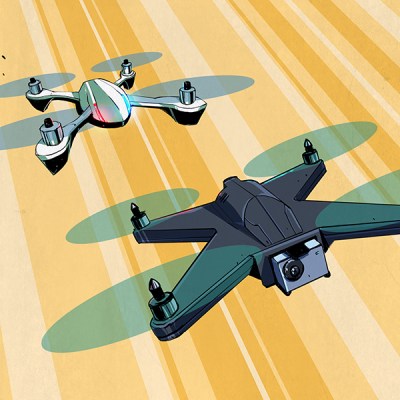 We can do the same thing with drones. Let’s create an innovation “sandbox” with de minimus regulatory barriers for small UAVs flying within very constrained environments. The parameters of the sandbox could be almost anything, as long as they’re clear, but it should be kinetic energy and range based (a limit of 2kg and 20m/s at 100m altitude and 1,000m range within visual line of sight would be a good starting point).
We can do the same thing with drones. Let’s create an innovation “sandbox” with de minimus regulatory barriers for small UAVs flying within very constrained environments. The parameters of the sandbox could be almost anything, as long as they’re clear, but it should be kinetic energy and range based (a limit of 2kg and 20m/s at 100m altitude and 1,000m range within visual line of sight would be a good starting point).
As in the case of open spectrum, in relatively low risk applications, such as micro-drones, technology can be allowed to “self-deconflict the airspace” without the need for monopoly exclusions such as exclusive licences or regulatory permits. How? By letting the drones report their position using the same cellphone networks they used to get permission to fly in the first place. The FAA already has a standard for this, called ADS-B, which is based on transponders in each aircraft reporting their position. But those transponders are expensive and unnecessary for small drones, which already know their position and are connected to the cloud. Instead, they can use “virtual ADS-B” to report their position via their cell network connections, and that data can be injected into the same cloud data services they used to check if their flight was safe in the first place.
Once this works, we’ll have a revolution. What WiFi did the telecoms industry, autonomous, cloud-connected drones can do to the aerospace industry. We can occupy the skies, and do it safely. Technology can solve the problems it creates.
About the Author
 Chris Anderson (@Chr1sa) is the CEO of 3D Robotics and founder of DIY Drones. From 2001 through 2012 he was the Editor in Chief of Wired Magazine. Before Wired he was with The Economist for seven years in London, Hong Kong and New York.
Chris Anderson (@Chr1sa) is the CEO of 3D Robotics and founder of DIY Drones. From 2001 through 2012 he was the Editor in Chief of Wired Magazine. Before Wired he was with The Economist for seven years in London, Hong Kong and New York.
The author of the New York Times bestselling books The Long Tail and Free as well as the Makers: The New Industrial Revolution.
His background is in science, starting with studying physics and doing research at Los Alamos and culminating in six years at the two leading scientific journals, Nature and Science.
In his self-described misspent youth [Chris] was a bit player in the DC punk scene and amusingly, a band called REM. You can read more about that here.
Awards include: Editor of the Year by Ad Age (2005). Named to the “Time 100,” the newsmagazine’s list of the 100 most influential people in the world (2007). Loeb Award for Business Book of the Year (2007). Wired named Magazine of the Decade by AdWeek for his tenure (2009). Time Magazine’s Tech 40 — The Most Influential Minds In Technology (2013). Foreign Policy Magazine’s Top 100 Global Thinkers (2013).


